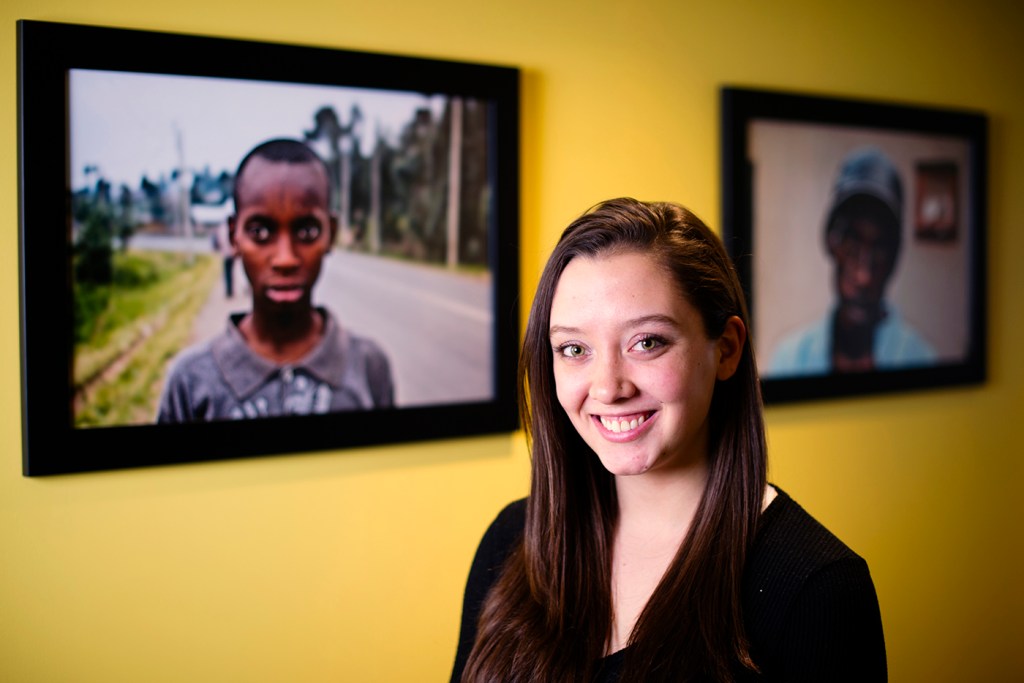Student photographer captures life in post-genocide Rwanda

“I’m deeply passionate about the role of photography in illuminating personal contexts,” says Ali Campbell, SSH’17.
Nowhere is this more evident than in her new collection of portraits and landscapes of post-genocide Rwanda. Here is a smiling boy, clothed in a mud-caked T-shirt emblazoned with the Superman shield. There is a black-and-white spotted cow in a patch of tangled shrubbery, the lone animal in a vast expanse of farmland.
Campbell, a third-year combined major in political science and international affairs, captured life in Rwanda last year, taking hundreds of photos as part of her ongoing research project to examine the visual representations of genocide and the politics of memory. She is working with Natalie Bormann, an associate teaching professor of political science who studies trauma, memory, and identity in global politics with a particular focus on the Holocaust.
“The overarching intent of the research is to better understand and explain the politics of traditional atrocity footage and to examine post-trauma identity,” says Campbell, who received an Office of the Provost Undergraduate Research Award to support her work.

For Campbell, this photo of a boy in Kigali, the capital city of Rwanda, exemplifies the theme of Rwanda Unseen: As she put it, “Objectively ‘bleak’ circumstances are nonetheless a space for nuance and everyday dynamics.”
All in all, Campbell will be writing a series of academic essays on the subject; displaying her photographs in an upcoming exhibit titled “Rwanda Unseen,” whose opening reception is scheduled for March 24 at 6:30 p.m. in 909 Renaissance Park; and then presenting her findings at Northeastern’s Research, Innovation, and Scholarship Expo in April.
The photo exhibit, she explains, will aim to humanize life in post-genocide Rwanda, bringing civility to atrocity coverage and creating a visual record of the ongoing physical and social reconstruction of the African state. According to Bormann, “The photographs emphasize the strength and beauty of Rwanda and its peoples after the genocide. With these images, we are reminded that Rwandans are not simply victims of a horrendous past, but are active agents in shaping their present and future lives.”
‘This is not my tragedy’
More than 800,000 Rwandans were killed over the course of 100 days in 1994, slaughtered by a large group of extremists in the Hutu majority. As the United Human Rights Council puts it, “The Rwandan genocide resulted from the conscious choice of the elite to promote hatred and fear to keep itself in power.”
Campbell, for her part, described Rwanda as a “very traumatized place with a complex history,” an observation stemming from her first-hand experience there. Between July and December, she visited genocide memorial sites and conducted a comprehensive review of the literature on the politics of memory in a post-genocide state. At the same time, she worked on co-op at the National Commission for the Fight Against Genocide, examining media coverage of the atrocity, interviewing survivors, and organizing files from village courts set up in the wake of the mass slaughter.

“I want to use photography to facilitate difficult political conversations and bring awareness to different issues,” says Campbell.
Through it all, she never lost sight of her place nor her purpose, particularly as it related to her photo project. She’s a U.S. native, growing up Needham, Massachusetts, a suburb some 6,800 miles away from one of the most horrific massacres in world history. And she was only 1 when it happened. “This is not my tragedy,” she recalls thinking. “This is not something I have the right to go and appropriate.”
She knew that any photo she took—whether portrait or landscape—had to be used as a kind of tool to shed light on the atrocity, to help nullify genocide denial and revisionism. From Bormann’s perspective, mission accomplished. “As a photographer,” she explains, “Ali is very aware of the role of those taking images and those in front of the lens, as well as the kinds of responsibilities we have when capturing images of people and places with a history such as Rwanda.”

Campbell shot this photo in Kibuye, a town along the shores of Lake Kivu in Rwanda. “The diver spent hours practicing,” she said, “alternating between diving and chatting with many local fishermen.”
A history of activism
Campbell’s work in the country dovetails with her long history of social and political activism. In high school, she worked for President Barack Obama’s re-election campaign while volunteering for nonprofits like Flying Kites and Global Youth Groove, both of which run programs in Kenya.
Over the past two years, she has gravitated toward the startup world, eschewing politics to harness the power of photography to effect social change and find her true calling. Today, she works as a marketing and photography associate at ArtLifting, an online marketplace for homeless and disabled artists. And that’s when she’s not running her own award-winning photography business, aimed at events and portraiture.
“I want to use photography to facilitate difficult political conversations and bring awareness to different issues,” she explains. “Being able to combine research with photography in Rwanda,” she adds, “has made it clear to me that I can pursue my creative side in many different ways.”





